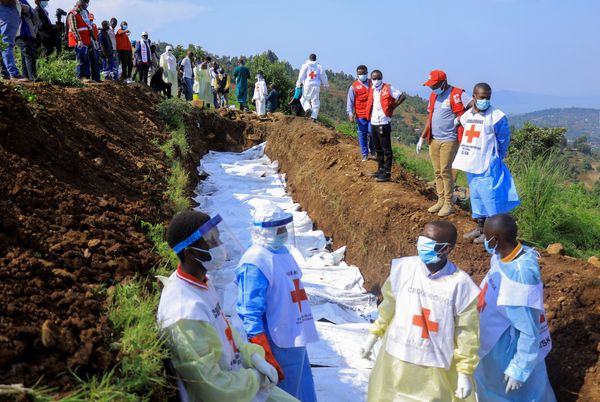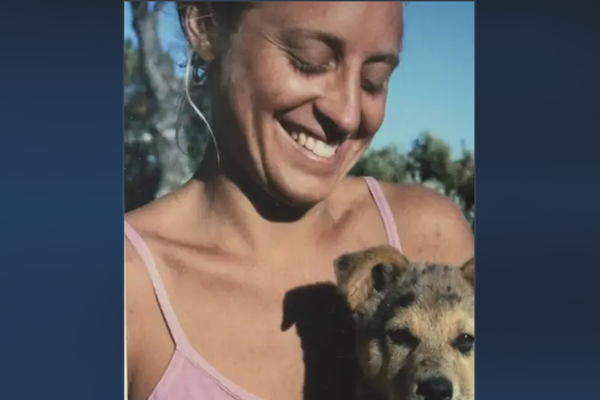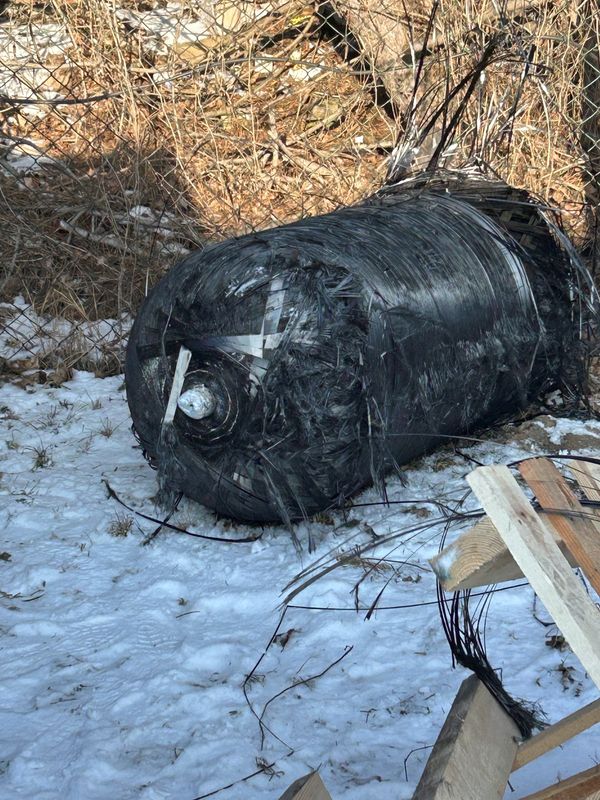It was a terrifying death for Ivan Milat's loneliest victim when 'Simi' Schmidl met her fate in the Belanglo State Forest. WARNING: Graphic
WARNING: Graphic
It was the loneliest of deaths for Simone Loretta Schmidl, solo, terrified and in the hands of a sadist and serial killer in a forest clearing far from home.
Of all the backpackers Ivan Milat murdered, the slaying of "Simi", as her friends called her, was particularly cruel.
Probably, Simi was aware of her impending death for some time, Milat severing her spine in two places to render her paralysed before the final, fatal stab wounds.
They were 40m off a bushfire trail in the Belanglo State Forest known as Miner's Despair.
/arc-anglerfish-syd-prod-nzme.s3.amazonaws.com/public/OI2KOXDAKBHYPCIY7P3TDY2ABM.jpg)
It was Sunday, January 20, 1991 and Simi had left Sydney around 8.15am.
The young commercial assistant from the Bavarian city of Regensburg had struck out on her own, leaving her German-Australian friend Jeanette Mueller to hitchhike alone to Melbourne.
She had brushed away Jeanette's warnings not to do so.
Simi said the tourist book she'd read said it was safe to hitchhike because "all Australians were warm and friendly", and anyway, she was carrying a knife.
Simi and Jeanette had just been hitchhiking together around Australia and New Zealand for several weeks, mostly getting lifts with truck drivers.
"It's pretty safe, especially with truckies," Ms Mueller would say later.
"I think she didn't get a lift with a truckie, she wanted to get in a normal car because she thought it would be faster getting to Melbourne."
Simi had left the Guildford home where they had been staying to travel by bus the 15km to the Hume Highway at Liverpool from where she would hitch.
She had four days to get to Melbourne airport and meet her mother, Erwinea, off the plane from Munich.
The pair was especially close and planned a six week campervan tour of Victoria before flying home together back to Germany.
An only child of divorced parents, Simone was outgoing, adventurous and personable.
"She always introduced herself as 'Simi' and was very friendly," Jeanette Mueller later said.
"She talked a lot, and liked to communicate with people to improve her English."
When Jeanette gave her a hug and said goodbye, Simone was wearing a yellow singlet she'd bought in New Zealand, khaki shorts and stout walking boots.
She wore large, black-framed glasses, her brunette dreadlocks were tied up in a "compact-o-mat" headband and she carried a huge backpack.
In it were a Salewa brand sleeping bag, a green water bottle with "Simi" scratched into it, a Vaude Hogan brand tent with pegs and cords, and a portable German brand cooking set.
/arc-anglerfish-syd-prod-nzme.s3.amazonaws.com/public/NU34U3PRT5BFJJBRN54NRVUX2Q.jpg)
She was tall, like her father Herbert, and waiting on the highway at Casula near Liverpool in southwestern Sydney, her distinctive look would later spark the memory of passing motorists.
The motorist who stopped was Ivan Milat, a road worker who had recently celebrated his 47th birthday and had two days of holiday left from his Christmas break.
He was driving a silver four-wheel drive and by the time he picked up Simone Schmidl, he had already murdered at least two people.
Just over a year earlier, on December 30, 1989, Milat had picked up Victorians Deborah Everist and James Gibson, both 19.
They were heading for the border town of Albury for the alternative bush festival Confest.
They were meant to be travelling with friends, but because of a mix-up the mates had already left Sydney, meaning Deborah and James had to make the journey on their own.
The young couple's bodies had lain deep in Belanglo Forest since, in a particularly remote section 500m from a walking reserve known as Executioner's Drop.
They would remain there until October 5, 1993, when a bushman collecting firewood discovered their bones.
/arc-anglerfish-syd-prod-nzme.s3.amazonaws.com/public/4I6MMPPSYZDGPE6WWSYROAHEXU.jpg)
Less than a month later, five kilometres away in the same forest, police would find Simone.
How she got there is not in dispute.
But what exactly happened to Simone after the last sighting of her on the Hume Highway near Liverpool in western Sydney can only be pieced together.
The only living witness to Ivan Milat's murderous cruelty, Paul Onions, was hitchhiking south from Sydney a year earlier than Simone Schmidl, in January 1990.
A "friendly" man with a Merv Hughes moustache stopped his white Toyota LandCruiser at a shop near Mittagong, in the NSW Southern Highlands, and offered him a lift.
The man who called himself Bill made the Englishman uneasy with some racist comments, and then pulled his vehicle over near the entrance to the Belanglo State Forest.
Bill said he was getting out some music tapes, although there were cassettes already in the car front, then pulled out a pistol and a length of rope and said "this is a robbery".
Onions, who had spent five years in the Royal Navy, was instantly terrified, more so by the rope than the gun.
"As soon as I seen the rope, I thought that's going to take a bit of time and he's going to do whatever he wants," Onions later said.
"I just thought, 'This is it, run or die'', so I undid my seatbelt and jumped straight out of the vehicle and ran."
/arc-anglerfish-syd-prod-nzme.s3.amazonaws.com/public/Y7XPY5ZEZVGEFDD7B3F2FDC77Q.jpg)
Onions had left his wallet, passport and all his belongings in the vehicle.
Milat shot at Onions until he managed to stop a passing car by jumping in front of it.
Simone Schmidl clearly remained in Milat's vehicle as he turned west off the Hume Highway, past the Belanglo State Forest sign which reads "please be careful", into Belanglo Road.
At 175cm tall, she was about Milat's height, but he was strong from physical labour and lifting weights; her knife would be no match to his loaded firearm.
Milat drove her along forest roads for 8km until they came to a site, like all of Milat's other burial grounds, relatively flat in an area dominated by steep gorges and winding gullies.
Probably already tied up, Simi was taken from the car 40m to an small clearing.
Before or after he had severed her spinal cord, Milat built a campfire ringed by stones in a near perfect circle.
He would then stab poor Simi six more times, puncturing her heart and lungs, and leave her body face down with her hands crossed.
Milat would cover Simi's body with a coffin-like canopy of leaves, ferns and twigs, with branches in an "X" configuration.
On January 24, Erwinea Schmidl flew into Melbourne airport.
She was excited to be meeting up with Simone, with whom she had spoken just days before.
/arc-anglerfish-syd-prod-nzme.s3.amazonaws.com/public/ZD5S6TRF7VDYTD6WO4JNSAJ3XQ.jpg)
Back in Regensburg, Germany, Herbert Schmidl was feeling hopeful.
His daughter would have a final adventure with her mother and then both would be home.
Simone had left Regensburg, a medieval city of the River Danube on September 29, 1990.
He had driven her at 5.30am to the train station, where Simi's friends from the Regensberg gymnastics club had gathered with a banner bearing her name to say farewell.
They considered her daring and admirable.
Herbert Schmidl was not so sure.
He would later tell Jaques Buval, Munich-based author of Der Rucksackmörder, that he did not like the idea of his 21-year-old daughter travelling around Australia with a backpack and a tent on her own.
He had tried to talk her out of the trip, but realised he could not make her change her mind.
Simi had previously travelled overseas and would not be put off.
She told him, "I'll be home safely … I'll be back home in six months."
To wild cheers from the gymnasts, Simone left.
Her return flight was booked for March 2, 1991.
When Erwinea Schmidl saw the crowds thin at Melbourne airport with still no sign of her daughter, she sought help from the information desk.
A German interpreter was found and Mrs Schmidl was taken to a police station to report Simone missing.
/arc-anglerfish-syd-prod-nzme.s3.amazonaws.com/public/LC5I5E65GNE6RFLHI5FQNUPKBQ.jpg)
Eventually, police flew Jeanette Mueller down from Sydney and the distraught Erwinea gave a press conference, with Jeanette translating, about her missing daughter.
Ms Mueller told journalists Mrs Schmidl thought the worst had happened.
"Simone would not have been careful who she hitchhiked with," Ms Mueller said.
"She just wanted to get to Melbourne as quickly as possible to meet her mother.
"She knew there was danger in hitchhiking on her own.
"She had a knife with her in case she got into trouble, but it wouldn't have been enough.
"We still have hope, but it is running out; it's too long without hearing anything."
In Germany, Herbert was alarmed to learn Simi had failed to meet his ex-wife.
Herbert Schmidl told author Jaques Buval he had felt he would never see Simone again when he farewelled her at Regensburg station.
He turned to the local police "in our grief, despair, anger, and unbelievable fear" to make a missing persons report.
He was told that in Germany people disappeared and then reappeared all the time.
Two other German families, of Anja Habschied, 20, and Gabor Neugebauer, 21, would report their loved ones missing in Australia.
The young couple vanished on December 26, 1991, after telling their parents they planned on leaving Australia to return home.
Caroline Clarke, 21, and Joanne Walters, 22, of England and Wales would also enter the missing persons list after disappearing on April 18, 1992.
/arc-anglerfish-syd-prod-nzme.s3.amazonaws.com/public/7INI4EUUMVBTHLRK7EEB2YMDTE.jpg)
Five months later, the Belanglo State Forest would give up its first clues leading to Ivan Milat's door.
On September 19, 1992, orienteering competitors in the forest discovered a corpse, of Joanne Walters.
The following morning police found a second body 30m away, that of Caroline Clarke.
Ms Clarke has been shot ten times in the head, leading detectives to later conclude she had been used as target practice.
Ms Walters had been stabbed 14 times; the nine stab wounds in her back would have paralysed her.
A further search by police yielded nothing.
On October 5, 1993, a bushman collecting firewood 500m from the British girls' burial site found an intact skeleton.
It was the remains of James Gibson, in a foetal position with his shoes on, and fragments of the black floppy hat he wore constantly nearby.
He had been stabbed eight times, a large knife cut through his upper spine which would have paralysed him, and wounds to his back and chest which would have punctured his heart and lungs.
Ms Everist's remains had been scattered.
At a small clearing overlooking a steep gorge, was an old camp fire ringed by stone. Near stands of yellow wattle trees and stringy bark gum, was a vertebrae.
Ms Everist had been savagely beaten; her skull was fractured in two places, her jaw was broken and there were knife marks on her forehead. She had been stabbed once in the back.
Less than a month of intense searching later, 5km northeast from the bush graves of Ms Everist and Mr Gibson, police found another set of remains.
Wrapped around the skull was a 'compact-o-mat' headband.
/arc-anglerfish-syd-prod-nzme.s3.amazonaws.com/public/VWP5YX7IBZCJXPK6OCT74PWGVM.jpg)
A forensic pathologist and a dental pathologist confirmed they were those of Simone Schmidl.
Her skeleton still wore a pair of shoes and other items of clothing were still visible on it.
A police spokesman said Miss Schmidl's relatives in Germany had been notified of the find.
Herbert Schmidl was driving a bus on his shift in Regensburg when his ex-wife Erwinea appeared at his end stop.
He knew by her face that his beloved Simone had been found.
He had already come to terms with the fact his only child was dead, but he didn't grieve any less.
/arc-anglerfish-syd-prod-nzme.s3.amazonaws.com/public/KQX5MLS3ARFX7C6XKUTYZHSBVI.jpg)
Erwinea had hard the news on the radio before police could contact either of them.
Three days after finding Simone, police located the decapitated body of Anja Habschied and the remains of Gabor Neugebauer, who had been shot in the head six times.
On May 22, 1994, officers from Task Force Air headed by Assistant Commissioner Clive Small surrounded the Eaglevale home of roadworker Ivan Milat in western Sydney.
In March 1996, Milat went on trial for the seven backpacker murders and the abduction of Paul Onions.
With his new wife Elfriede, Herbert Schmidl attended the murder trial along with the other parents of the victims.
/arc-anglerfish-syd-prod-nzme.s3.amazonaws.com/public/NCUQET3LT5CMXJM7MUJ4ZWTNL4.jpg)
After 18 weeks of testimony, on July 27, 1996 – the same day a bomb went off at the Atlanta Olympics and Kieren Perkins won gold in the 1500m freestyle – Ivan Milat was found guilty on all charges.
Herbert Schmidl told Jaques Buval he wanted the death penalty for Milat after his conviction.
He qualified the remark by saying execution should occur "immediately … I'm not a sadist like him. It should be short and painless, without agony".
Herbert Schmidl remained "a broken man" about the loss of his daughter Simi.
"When I think about all these years of suffering today, I wish for one thing – that no human being feels like me," he said.
"The pain will be easier in the course of time, but you will not finish until you close your eyes forever."
Serial killer Ivan Milat died, aged 74, on October 27, 2019, in custody after being diagnosed with cancer six months ago.







